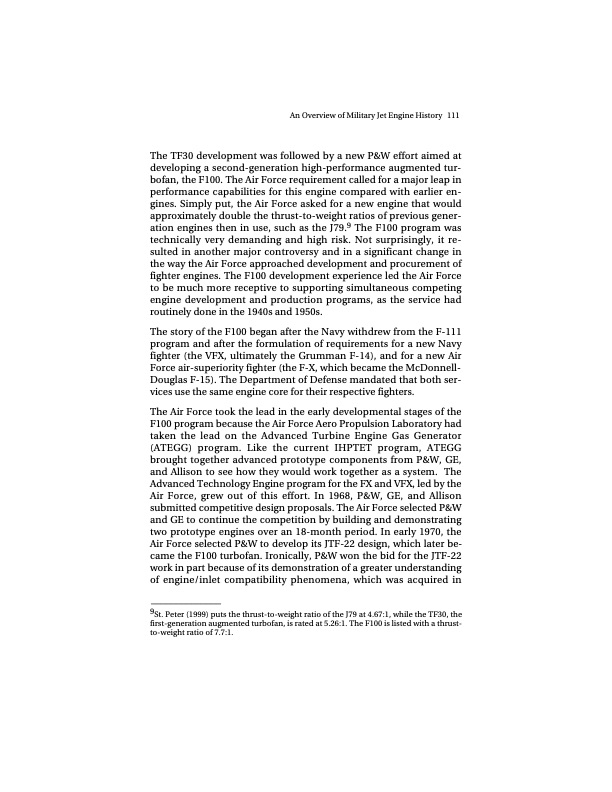
PDF Publication Title:
Text from PDF Page: 126
An Overview of Military Jet Engine History 111 The TF30 development was followed by a new P&W effort aimed at developing a second-generation high-performance augmented tur- bofan, the F100. The Air Force requirement called for a major leap in performance capabilities for this engine compared with earlier en- gines. Simply put, the Air Force asked for a new engine that would approximately double the thrust-to-weight ratios of previous gener- ation engines then in use, such as the J79.9 The F100 program was technically very demanding and high risk. Not surprisingly, it re- sulted in another major controversy and in a significant change in the way the Air Force approached development and procurement of fighter engines. The F100 development experience led the Air Force to be much more receptive to supporting simultaneous competing engine development and production programs, as the service had routinely done in the 1940s and 1950s. The story of the F100 began after the Navy withdrew from the F-111 program and after the formulation of requirements for a new Navy fighter (the VFX, ultimately the Grumman F-14), and for a new Air Force air-superiority fighter (the F-X, which became the McDonnell- Douglas F-15). The Department of Defense mandated that both ser- vices use the same engine core for their respective fighters. The Air Force took the lead in the early developmental stages of the F100 program because the Air Force Aero Propulsion Laboratory had taken the lead on the Advanced Turbine Engine Gas Generator (ATEGG) program. Like the current IHPTET program, ATEGG brought together advanced prototype components from P&W, GE, and Allison to see how they would work together as a system. The Advanced Technology Engine program for the FX and VFX, led by the Air Force, grew out of this effort. In 1968, P&W, GE, and Allison submitted competitive design proposals. The Air Force selected P&W and GE to continue the competition by building and demonstrating two prototype engines over an 18-month period. In early 1970, the Air Force selected P&W to develop its JTF-22 design, which later be- came the F100 turbofan. Ironically, P&W won the bid for the JTF-22 work in part because of its demonstration of a greater understanding of engine/inlet compatibility phenomena, which was acquired in ______________ 9St. Peter (1999) puts the thrust-to-weight ratio of the J79 at 4.67:1, while the TF30, the first-generation augmented turbofan, is rated at 5.26:1. The F100 is listed with a thrust- to-weight ratio of 7.7:1.PDF Image | Military Jet Engine Acquisition Technology Basics and Cost-Estimating Methodology

PDF Search Title:
Military Jet Engine Acquisition Technology Basics and Cost-Estimating MethodologyOriginal File Name Searched:
MR1596.pdfDIY PDF Search: Google It | Yahoo | Bing
NFT (Non Fungible Token): Buy our tech, design, development or system NFT and become part of our tech NFT network... More Info
IT XR Project Redstone NFT Available for Sale: NFT for high tech turbine design with one part 3D printed counter-rotating energy turbine. Be part of the future with this NFT. Can be bought and sold but only one design NFT exists. Royalties go to the developer (Infinity) to keep enhancing design and applications... More Info
Infinity Turbine IT XR Project Redstone Design: NFT for sale... NFT for high tech turbine design with one part 3D printed counter-rotating energy turbine. Includes all rights to this turbine design, including license for Fluid Handling Block I and II for the turbine assembly and housing. The NFT includes the blueprints (cad/cam), revenue streams, and all future development of the IT XR Project Redstone... More Info
Infinity Turbine ROT Radial Outflow Turbine 24 Design and Worldwide Rights: NFT for sale... NFT for the ROT 24 energy turbine. Be part of the future with this NFT. This design can be bought and sold but only one design NFT exists. You may manufacture the unit, or get the revenues from its sale from Infinity Turbine. Royalties go to the developer (Infinity) to keep enhancing design and applications... More Info
Infinity Supercritical CO2 10 Liter Extractor Design and Worldwide Rights: The Infinity Supercritical 10L CO2 extractor is for botanical oil extraction, which is rich in terpenes and can produce shelf ready full spectrum oil. With over 5 years of development, this industry leader mature extractor machine has been sold since 2015 and is part of many profitable businesses. The process can also be used for electrowinning, e-waste recycling, and lithium battery recycling, gold mining electronic wastes, precious metals. CO2 can also be used in a reverse fuel cell with nafion to make a gas-to-liquids fuel, such as methanol, ethanol and butanol or ethylene. Supercritical CO2 has also been used for treating nafion to make it more effective catalyst. This NFT is for the purchase of worldwide rights which includes the design. More Info
NFT (Non Fungible Token): Buy our tech, design, development or system NFT and become part of our tech NFT network... More Info
Infinity Turbine Products: Special for this month, any plans are $10,000 for complete Cad/Cam blueprints. License is for one build. Try before you buy a production license. May pay by Bitcoin or other Crypto. Products Page... More Info
| CONTACT TEL: 608-238-6001 Email: greg@infinityturbine.com | RSS | AMP |